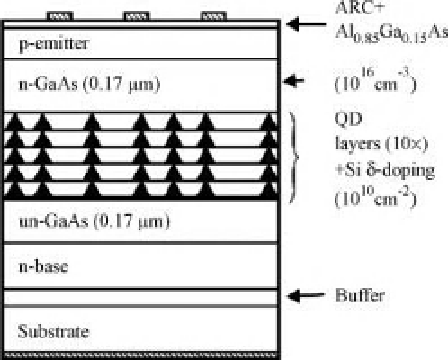Environmental Engineering Reference
In-Depth Information
Figure 8.5 Example of intermediate band solar
cell [104] based on quantum dots. Here,
ARC
represents
antireflection coating
and
d-doping
means a pure deposit, in this case of
Si. The indicated quantum dots are InAs, which
have also been used to lower the threshold
current in versions of GaAs heterojunction
lasers. The authors [104] found extra
photocurrent in this structure arising from lower
energy photons, substantiating an aspect of the
model depicted in Figures 8.2
8.4.
-
The carrier multiplication process that occurs within the extremely pure
semiconductor creates
n
(
hf
/
E
g
)electron
-
hole pairs from the initial high-energy
electron
-
hole pair. The high-energy carriers reduce their kinetic energy by colli-
sions creating additional electron
-
hole pairs of lower energy, and in this
process loss of energy to lattice vibrations (phonons) apparently is not an important
effect.
A similar process would be beneficial in the efficiency of solar cells, to capture
energy from the portion of the solar spectrum in the range
hf
¼
E
g
. This process in a
solar cell could multiply the conversion efficiency by a large factor.
The idea of a quantum dot was given in connection with Equations 2.11
-
2.16, and
later in section 3.3.1 of Chapter 3. The wavefunction Equation 2.16 and energy level
Equation 2.11 of a single electron in a con
>
ning potential of width
L
is given in
Chapter 2 and generalized to three dimensions in Chapter 3, see Equation 3.15.
In the present context, quantum dots are 3D structures introduced locally in a
junction device such as a solar cell or junction laser.
A quantum dot may be called an arti
cial atom, characterized by discrete sharp
electron energy states, and sharp absorption and emission wavelengths for photons.
Transmission electronmicroscope (TEM) images of such nanocrystals, whichmay
contain only 50 000 atoms, reveal perfect crystals having the bulk crystal structure
and bulk lattice constant. Quantitative analysis of the light emission process in QDs
suggests that the bandgap, effective masses of electrons and holes, and other
microscopic material properties are very close to their values in large crystals of
the same material. The light emission comes from radiative recombination of an
electron and a hole, created initially by the shorter wavelength illumination.

